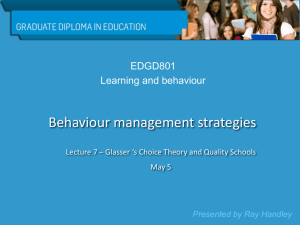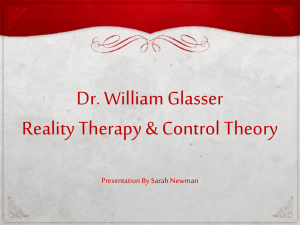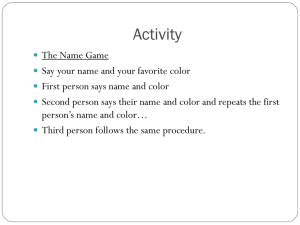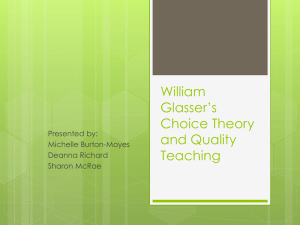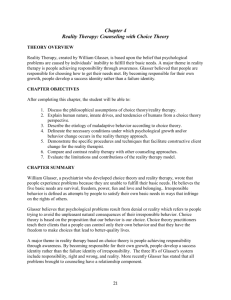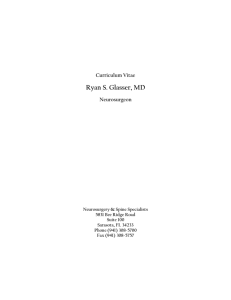on Quality Schools
advertisement
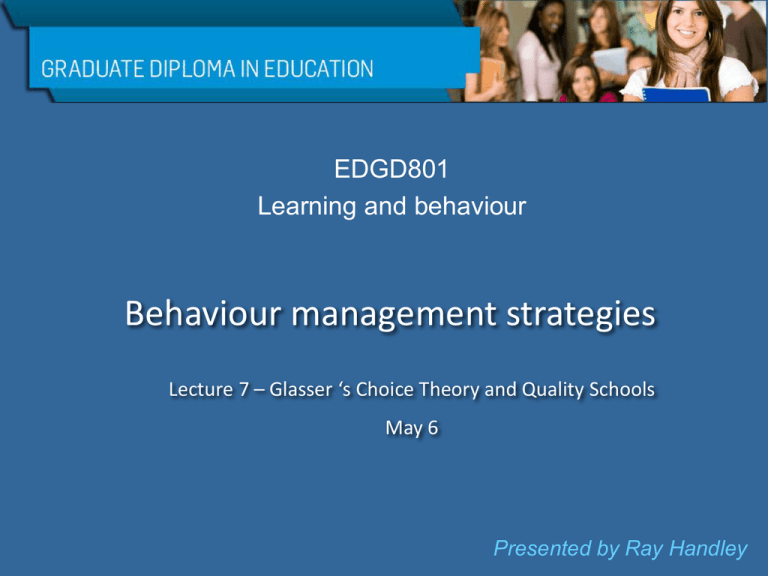
EDGD801 Learning and behaviour Behaviour management strategies Lecture 7 – Glasser ‘s Choice Theory and Quality Schools May 6 Presented by Ray Handley Overview of this week Glasser on education Choice Theory Quality schools Changing paradigms – Ken Robinson Presented by Ray Handley EDGD801 : Glasser on Choice & Quality Jacob Kounin Bill Rogers Humanism Decisive Discipline Ginott/Rogers Group Management Fred Jones Neo-Adlerian Positive Discipline Balson/Dreikurs Systems Theory Solution focussed Applied Behaviour Analysis Behaviour Modification Canter & Canter Assertive Discipline Choice Theory William Glasser Cognitive-behaviourism Models of Behaviour Management Continuum Autocratic Democratic StudentLaissez-faire empowered Limit Setting Leadership Internal Non-directive motivation Quotes . . . on behaviour change What we have to understand is that the only life we can control is our own and, in almost all instances, we can choose to change. Good or bad, everything we do is our best choice at that moment. It is almost impossible for anyone, even the most ineffective among us, to continue to choose misery after becoming aware that it is a choice Quotes . . . on behaviour change Never let anyone control you with the pain and misery he or she chooses. What happened in the past that was painful has a great deal to do with what we are today, but revisiting this painful past can contribute little or nothing to what we need to do now. The brain physiology associated with depressing is no more its cause than sweating is the cause of running. Quotes . . . on Quality Schools There are only two places in the world where time takes precedence over the job to be done. School and prison. The difference between school and life? In school, you're taught a lesson and then given a test. In life, you're given a test that teaches you a lesson. To counter the avoidance of intellectual challenge and responsibility, we must reduce the domination of certainty in education. After the results of a maths test were returned a student approached the teacher and asked why a particular answer was marked incorrect. The question concerned the best value from several options on the price of flour. The options were: a) 1kg bag for $1.50 b) 5 kg bag for $6.00 or c) 10 kg bag for $10.00 The teacher explained that c) was the best value as the flour only cost $1 per kg as opposed to $1.20 per kg in for the 5kg bag and $1.50 for the 1kg bag. The student then politely corrected the teacher and explained that in their household they did not use much flour and a 10kg bag would only end up being thrown out when the weevils got into it or it went mouldy. So a 1kg bag would be the best value for their situation. The teacher gave the student the mark for that question. East Asian countries East Asian countries What is takes to score well – an example from China “Since my daughter began 7th grade, she has had extra evening classes. At that time, the class ends at 6:50pm and I accepted it. But ever since she entered 9th grade, the evening class has lengthened to 8:40pm. For the graduating class, the students have to take classes from 7:30am to 8:00pm on Saturdays. There are also five weeks of classes during the winter and summer school vacation… After coming home after 10pm, she has to spend at least one hour on her homework. She has to get up at 5am. She is still a child. May I ask how many adults can endure this kind of work?” Source - http://news.xinhuanet.com/edu/2010-12/09/c_12863806_3.htm 2009 PISA Maths score Perceived entrepreneurial capacity % of people confident in their ability for entrepreneurship Global Entrepreneurship Monitor (GEM) TIMMS (2011) comparison of Year 8 Maths Trends in international mathematics & science study Maths score % confident Countries Quotes . . . on Quality Schools Running a school where the students all succeed, even if some students have to help others to make the grade, is good preparation for democracy. We can pay teachers a hundred thousand dollars a year, and we'll do nothing to improve our schools as long as we keep the A, B, C, D, F grading system. Quotes . . . on Quality Schools In a Glasser Quality School there is no such thing as a closed book test. Students are told to get out their notes and open their books. There is no such thing as being forbidden to ask the teacher or another student for help. Glasser has 6 conditions describing a quality school. These have been reworded below by Hoglund and Lindsey (link) 1. Quality occurs in a warm, supportive environment 2. Quality Work is useful. 3. Everyone does their best. 4. Constant Improvement. + 5. Quality Work feels good 6. Quality is never destructive. This is about achieving, performing, bettering NOT attempting, trying, effort. 1. Quality occurs in a warm, supportive environment Continually focus and work on having a positive, supporting, trusting classroom and school environment. This condition is one of the most difficult tasks to accomplish. To create the type of environment that is described requires individuals and groups to align perceptions and expectations. It also requires a commitment to working hard toward accomplishing this goal. 1. Quality occurs in a warm, supportive environment Reality Therapy is a method of working with others that is consistent with Choice Theory and essential for creating this environment. When used consistently, these questions have been proven to increase responsibility, and ultimately - happiness! Want Doing Evaluate Plan What do you want? What are you doing? Is it working? (helping / hurting?) What else can / will you do?. Choice Theory (Glasser) Our behaviour is directed at meeting our basic needs: Students can be focused on being aware of their behaviour and how best it can meet their needs. 2. Quality Work is useful. Everyone should be asked to do useful work. This applies even beyond the work that students are asked to do in class. It applies to the expectations and requirements of district and school administration, certified and classified personnel. Educators are continually challenged to determine what is and what is not worth learning. 2. Quality Work is useful. Everyone should be asked to do useful work. While some of the challenges are attempts to avoid work by students and/or faculties, many of the questions and their underlying premises are valid. Some of the questions are: · What is useful? · How will it be useful? · What is important? · What do you (the teacher/administrator) see as useful? Why? 3. Everyone does their best. Everyone is asked to give their best effort. The concept of doing one's best is confusing at times. The problem arises because there are two distinct and different uses of the word "best”. We propose that "best" does not always equate to quality. "Best" as defined in the conditions of quality means more than first effort. It implies the evaluation and revision of work, depth of knowledge and the realisation of its usefulness to the learner. PARACHUTE SCHOOL QUALITY CHECK RESULTS This example using results from a parachute school course that teaches how to fold parachutes illustrates the significance of mastery learning and highlights many of the inadequacies of our assessment systems. In this school students learn to fold parachutes for 7 weeks. Each week is assessed and a score given. The graph shows the results for 5 students over the 7 weeks. Students A, B, C and D all averaged around 70% for the course. Student E --- averaged 80%. Have a look at the patterns in these results and see which student you would want to be packing your parachute. Explaining this example Student E Ave. score 80% Ave score 62% 4. Constant Improvement. Ask everyone to evaluate and improve their own work when it is important to do so. One of the most valuable skills that anyone can have is the ability to evaluate their own work and effort and continue to improve whatever they are doing. While students are not the sole evaluators of all of their work, it is important to help them learn what quality work is, how they can best achieve it and how to evaluate their progress along the way. 5. Quality Work feels good 6. Quality is never destructive. These indicate the degree of quality work that we do. In addition, these points assess how well the other four conditions have been met. Assessment of quality work may be as simple as the positive feelings that one experiences prior to, during or upon completing goals, tasks, work, etc. The role of the teacher in a Quality School Glasser looks at the role of the teacher in 2 ways: 1. Communication style 2. Leadership style The role of the teacher in a Quality School 1. Communication style 7 caring habits 7 deadly habits 1) 2) 3) 4) 5) 6) 7) 1) 2) 3) 4) 5) 6) 7) Supporting Encouraging Listening Accepting Trusting Respecting Negotiating differences Criticising Blaming Complaining Nagging Threatening Punishing Bribing or rewarding to control The role of the teacher in a Quality School 2. Leadership style Boss managers: Lead Managers: Set tasks and standards without consultation Engage workers in discussion of work Tell rather than show Show or model the job Designate, inspect, grade Use coercion Ask workers to evaluate their own work Facilitate rather than coerce from Changing Paradigms – Ken Robinson http://www.ted.com/talks/ken_robinson_changing_education_paradigms.html Creativity, diversity and the changing needs of education Ken Robinson Hoglund, R. & Lindsey, E. (undated) Condition of Quality. Website. Accessed 1/4/2011 http://www.bobhoglund.com/conditions.htm Nelson, T.G. (2002) An interview with William Glasser. Website accessed 1/4/2011 http://findarticles.com/p/articles/mi_qa3960/is_200207/ai_n9097918/ Wubbolding, Robert E. 1,2 (2007) Group Dynamics: Theory, Research, & Practice. Special Issue: Groups in Educational Settings. 11(4):253-261, December. Glasser, W. (1969 – 2007) Various titles - Bibliography Glasser Institute – North East Region Quotes by Dr. Glasser Website accessed 25/04/2011 http://www.glassernortheast.com/index.php?option=com_content&task=vi ew&id=58&Itemid=107
